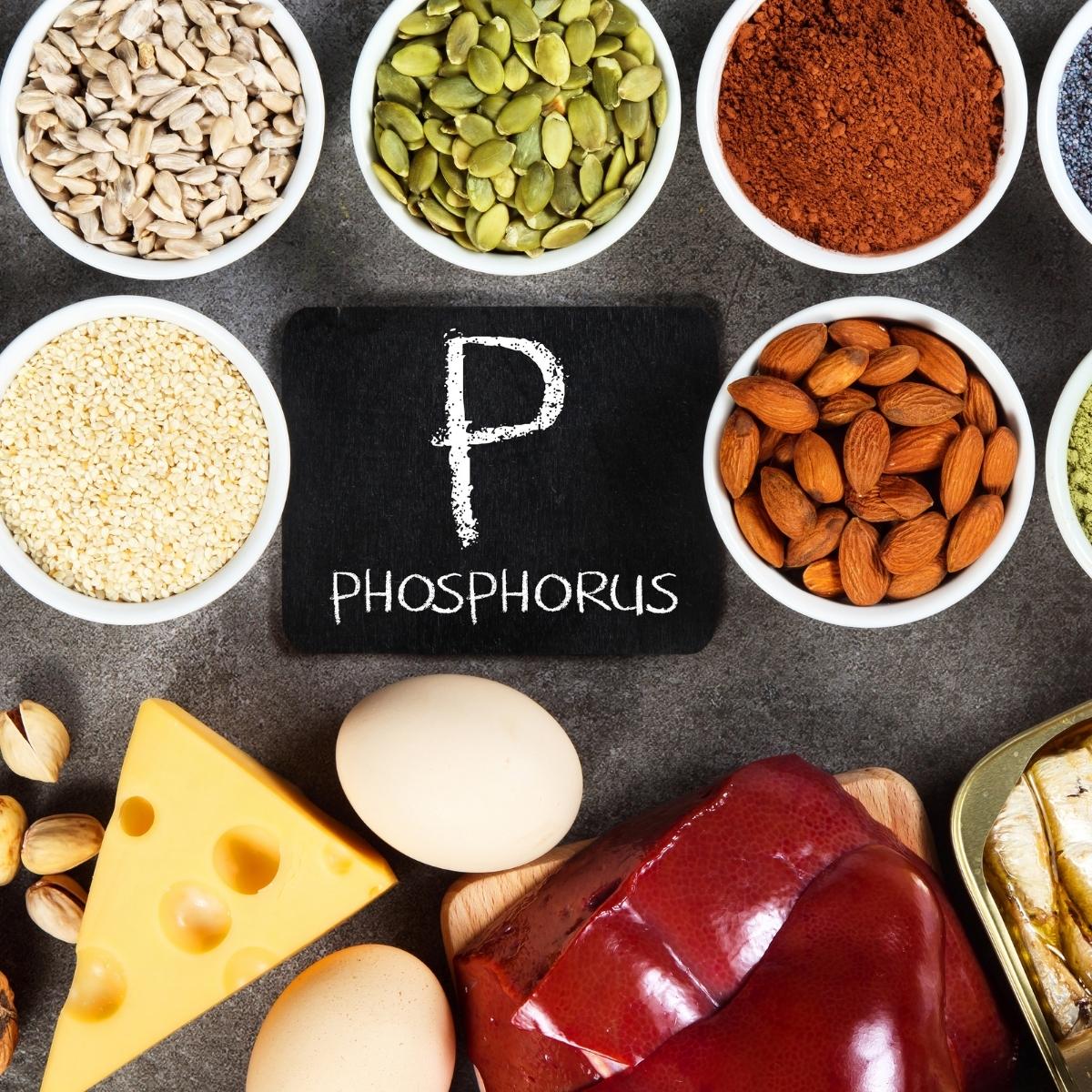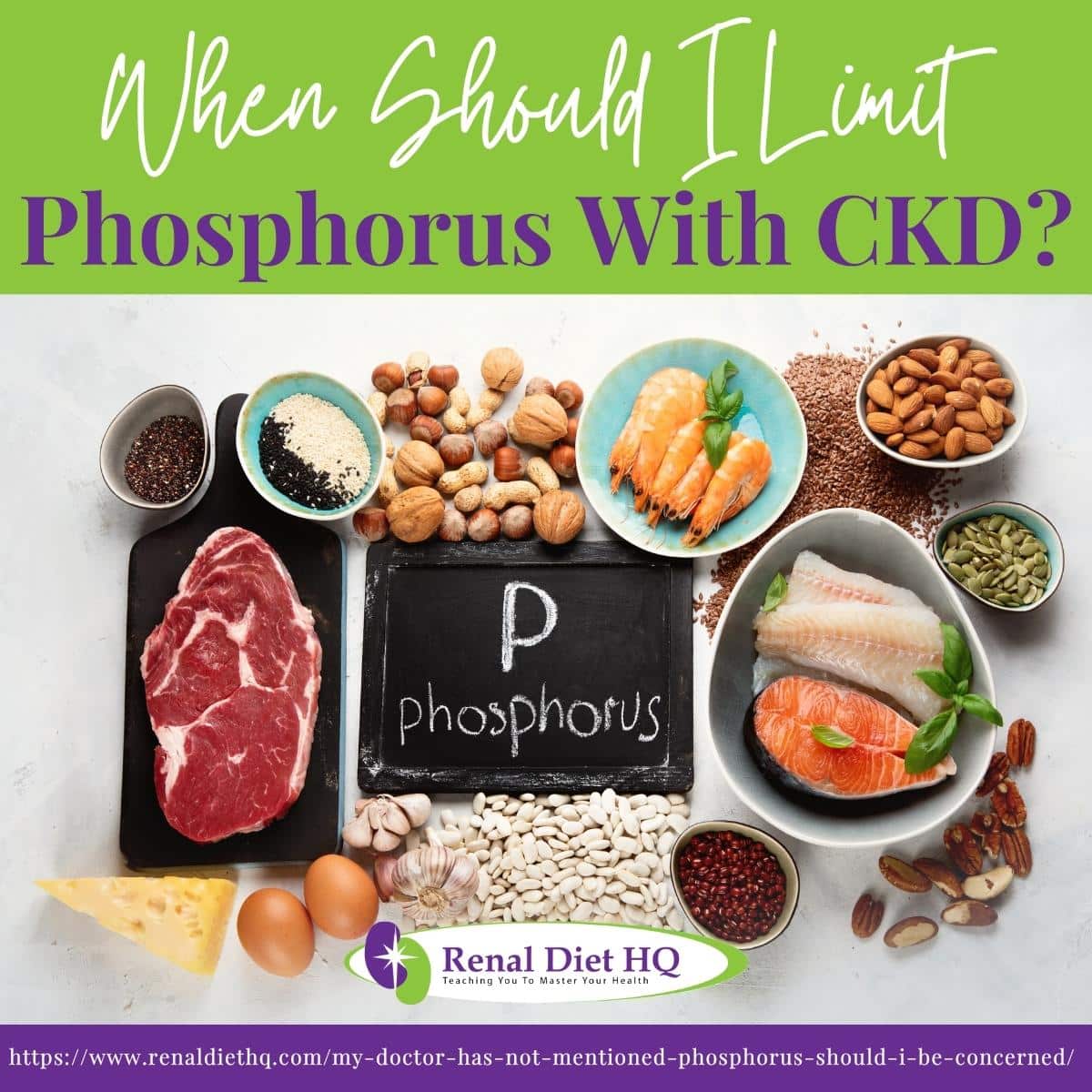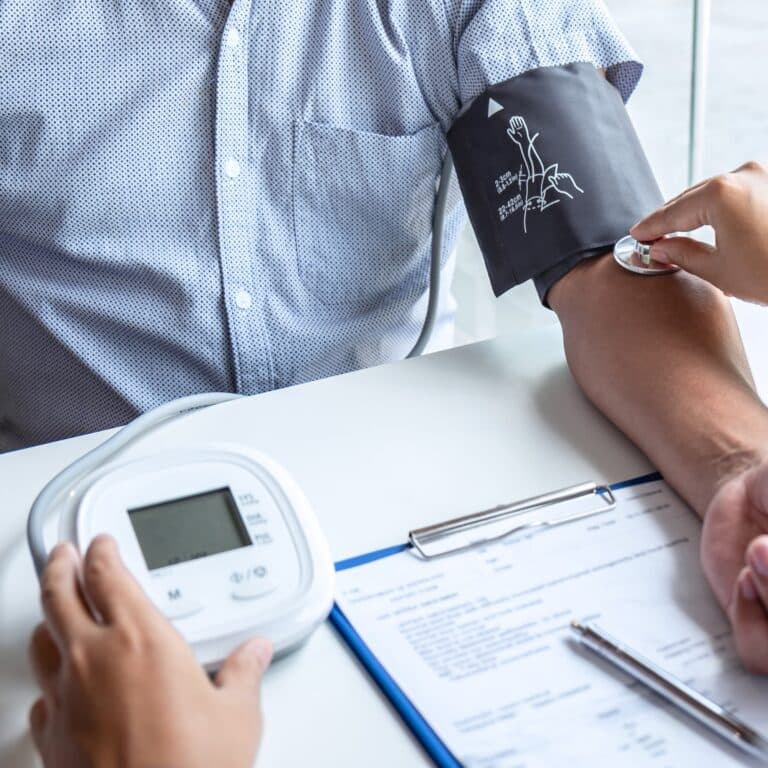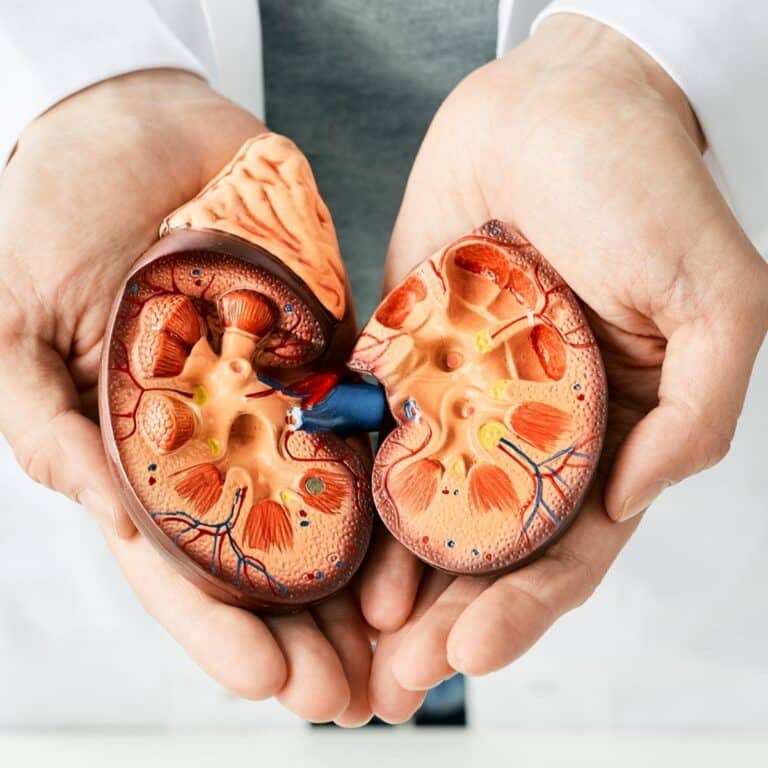When Should I Limit Phosphorus With CKD?
If you're living with chronic kidney disease (CKD), it's crucial to know when and how to limit your phosphorus intake. Phosphorus, an element found in many foods, plays a key role in energy creation but can be harmful if consumed excessively, especially for those with CKD.
High protein foods like dairy and meats are often rich in phosphorus - so where should you draw the line?

Understanding your dietary needs can feel overwhelming, but we're here to help. This article will guide you through understanding the connection between phosphorus and CKD, identifying high-phosphorus foods to avoid, strategies for lowering your intake, and more.
Jump to:
- Key Takeaways
- Understanding Phosphorus and Its Role in the Human Body
- The Connection Between Phosphorus and Chronic Kidney Disease (CKD)
- When Should You Start Limiting Phosphorus in Your Diet?
- How Much Phosphorus is Too Much for CKD Patients?
- Identifying High-Phosphorus Foods to Avoid
- The Role of Protein in Phosphorus Intake
- Phosphorus Binders: An Effective Way to Control Phosphorus Levels
- The Importance of Discussing Your Diet with Your Doctor
- How Dialysis Affects Your Phosphorus Levels
- Strategies for Lowering Your Phosphorus Intake
- Reading Food Labels for Phosphorus Content
- The Impact of Dietary Changes on the Progression of CKD
- FAQS for Limiting Phosphorus With CKD
- Limiting Phosphorus in Your Diet Limits CKD Progression and Complications
Key Takeaways
- Limiting phosphorus intake should start early in kidney disease to avoid harm.
- High protein foods, like dairy and meats, should be limited to reduce phosphorus intake.
- Phosphorus binders can be used to manage phosphorus levels in conjunction with dietary choices.
- Regular check-ups with a doctor and open communication about diet are important for managing kidney disease and phosphorus levels.

Understanding Phosphorus and Its Role in the Human Body
Phosphorus is an essential mineral that plays a crucial role in the human body. It is abundant in the body, with about 85% of phosphorus found in bones and teeth in the form of calcium phosphate, providing strength and structure. The remaining 15% is present in cells, tissues, and body fluids, where it serves various vital functions.
One of the most important roles of phosphorus is in energy production. Phosphorus is a key component of adenosine triphosphate (ATP), which is the primary molecule used by cells to store and transfer energy.
During cellular respiration, ATP releases energy when it is broken down into adenosine diphosphate (ADP) and a phosphate group. This energy release is then utilized for various cellular processes, enabling the body to perform essential functions such as muscle contractions, nerve impulses, and maintaining body temperature.
Phosphorus also plays a significant role in cellular signaling and communication. It is involved in the synthesis and activation of various enzymes, hormones, and other signaling molecules that regulate cellular processes. Moreover, phosphorus is essential for DNA and RNA, the genetic material responsible for protein synthesis and cellular replication.
Additionally, phosphorus is vital for maintaining the body's acid-base balance. It acts as a buffer to regulate pH levels, ensuring that bodily fluids remain within a narrow and healthy pH range.
While phosphorus is crucial for numerous physiological functions, maintaining an appropriate balance is essential to maintain phosphorus homeostasis in the body. Excessive phosphorus intake, particularly in individuals with impaired kidney function, can lead to hyperphosphatemia, a condition associated with complications such as cardiovascular disease and bone abnormalities.
Therefore, individuals with kidney disease are often advised to monitor their phosphorus intake closely as part of their dietary management. Overall, phosphorus is an indispensable mineral in the human body, supporting energy production, cellular function, and various other vital processes necessary for overall health and well-being.
The Connection Between Phosphorus and Chronic Kidney Disease (CKD)
You might not be aware, but there's a significant relationship between your phosphorus intake and the progression of chronic kidney disease. As your kidneys struggle to maintain proper phosphorus levels, you may need to adjust your diet and possibly incorporate medications known as phosphorus binders.
Here are some phosphorus intake control measures, along with their impact and simple recommendations for each.
| Phosphorus Control | Impact on CKD | Recommended Actions |
| High Phosphorus Intake | Accelerates CKD Progression | Limit Foods High in Phosphorus |
| Inefficient Absorption | Accumulates in Bloodstream | Use Phosphorus Binders with Meals |
| Low Protein Diet | Reduces Phosphorus Levels | Monitor Dietary Intake Regularly |
The connection between phosphorus and chronic kidney disease lies in the impaired ability of the kidneys to regulate phosphorus levels in the body. Normally, healthy kidneys efficiently filter and excrete extra phosphorus through urine, maintaining a delicate balance. However, in CKD, the kidneys' function deteriorates, leading to reduced filtration capacity.
As a result, phosphorus accumulates in the blood, causing a condition known as hyperphosphatemia. Elevated phosphorus levels can have adverse effects on the body, including the formation of calcium-phosphate deposits in blood vessels and soft tissues, leading to vascular calcification and increased cardiovascular risk.
Moreover, excess phosphorus can disrupt the balance of calcium and phosphorus in bones, weakening them and contributing to renal osteodystrophy or chronic kidney disease-mineral bone disorder, a condition characterized by bone abnormalities and fractures.
To manage hyperphosphatemia in CKD, dietary restrictions on foods with phosphorus, and phosphate binders are used. Controlling phosphorus levels is vital in CKD to reduce the risk of complications, preserve strong bones, and lower risk of cardiovascular mortality.
For More Recipes and Ideas --->> Get Your Free Meals and Recipes That Are Perfect for Pre-Dialysis Diets, Pre-Dialysis with Diabetes, or Dialysis Diets.
When Should You Start Limiting Phosphorus in Your Diet?
It's crucial to start tweaking your diet at the earliest signs of kidney trouble, even before dialysis becomes necessary. Recognizing when to limit phosphorus is a key aspect of managing Chronic Kidney Disease. Managing phosphorus intake helps slow the disease's progression and maintain better overall health.
The importance of phosphorus control cannot be overstated for CKD patients. Your kidneys process most dietary phosphorus, but as their function declines, they struggle with this task.
The single most important thing you can do to reduce the rate of progression of your kidney disease is to lower the amount of protein that you eat which will naturally lower your phosphorus consumption. At your nephrologist’s or dietitian’s advice, it may be advisable to lower your protein intake (and therefore, your phosphorus intake) once you are diagnosed with chronic kidney disease.
Strategies for phosphorus reduction include choosing foods lower in protein, reading labels diligently for hidden sources of this mineral, and considering the use of binders that prevent absorption of phosphorus. Remember though, these binders work best when taken with meals.
Controlling your intake doesn't mean eliminating all high-phosphorus foods from your life instantly; it means being mindful about how much you consume each day. As you navigate through this journey with CKD, remember that every small step towards controlling your dietary phosphorus counts and has a significant impact on kidney disease progression. Stay informed and proactive, it makes a world of difference!
How Much Phosphorus is Too Much for CKD Patients?
For CKD patients, managing phosphorus intake is crucial due to the impaired ability of the kidneys to regulate phosphorus levels. Excess phosphorus can lead to complications such as vascular calcification and bone disorders. The recommended daily intake for individuals with CKD is generally limited to 800-1000 mg per day of phosphorus.
In the early chronic kidney disease stages, when kidney function is relatively preserved, dietary phosphate restriction may not be as crucial. However, as CKD progresses, and kidney function declines, more stringent phosphorus control becomes essential. This is particularly relevant in stage 3 and beyond, up to end stage renal disease.
Phosphorus is present in a wide range of foods, including dairy products, meats, nuts, seeds, and processed foods. It is also commonly used as a food additive, further contributing to dietary phosphorus intake.
CKD patients are often advised to limit their consumption of foods rich in phosphate content and opt for lower-phosphorus alternatives. Reading food labels and choosing products with lower phosphorus content can help individuals manage their phosphorus intake more effectively.
Additionally, phosphate binders are often prescribed to CKD patients to reduce phosphorus absorption from the diet and minimize its buildup in the blood. These medications bind to dietary phosphorus in the gastrointestinal tract, preventing intestinal absorption into the bloodstream.
Working with a registered dietitian who specializes in renal nutrition is crucial for CKD patients to develop a personalized meal plan that meets their nutritional needs while adhering to phosphorus restrictions. Regular monitoring of phosphorus levels and adjusting dietary choices accordingly is essential to support kidney health and overall well-being.
Identifying High-Phosphorus Foods to Avoid
Knowing what's on your plate can make a world of difference, especially when it comes to identifying foods high in that sneaky mineral. The key is being aware of phosphorus sources and effectively managing your intake.
Here are some common high-phosphorus foods to be cautious of:
- Dairy Products: Milk, yogurt, cheese, and other dairy products are rich in phosphorus. Choose lower-phosphorus options like skim or low-fat milk, and limit cheese intake.
- Nuts and Seeds: Almonds, peanuts, sunflower seeds, and pumpkin seeds are high in phosphorus. Opt for lower-phosphorus nuts like cashews or macadamia nuts.
- Beans and Legumes: Beans like black beans, lentils, and peas are high in phosphorus. Choose lower-phosphorus options like green beans or snap peas.
- Processed Foods: Processed and convenience foods often contain phosphorus additives. Read food labels and avoid products with phosphorus additives, such as phosphoric acid.
- Colas and Dark Beverages: Colas and dark sodas such as root beer contain phosphoric acid and other drinks with phosphate additives, which increases phosphorus levels in the body. Choose clear sodas or water instead.
- Chocolate and Caramel: These sweet treats may contain phosphorus additives. Limit their consumption and opt for low-phosphorus desserts.
- Organ Meats: Liver, kidney, and other organ meats are high in phosphorus. Choose lean meats instead.
- Certain Grains: Bran and whole-grain products can be higher in phosphorus. Choose refined grains like white rice or pasta.
- Beer and Certain Alcoholic Beverages: Some alcoholic drinks can be high in phosphorus. Moderate alcohol consumption and opt for lower-phosphorus options if needed.
It is important for people with kidney disease to work with a registered dietitian to create a personalized meal plan that considers their specific dietary restrictions.
Monitoring levels of phosphorus and making informed choices about food and beverage consumption will help individuals manage their phosphorus intake and support their kidney health effectively.
The Role of Protein in Phosphorus Intake
When it comes to managing your dietary phosphorus, protein plays a surprisingly central role. There is a relationship between protein and dietary phosphorus intake. High-protein foods, such as cheese, milk products, and meats, are usually high in phosphorus. So when you decrease your protein intake, you naturally lower the amount of phosphorus that enters your system.
But remember that all proteins aren't created equal. Some plant-based proteins may contain less phosphorus than animal proteins. It's crucial to read food labels or consult kidney diet resources to make informed decisions.
Protein plays a significant role in phosphorus intake, particularly for individuals with chronic kidney disease. Many protein-rich foods, such as meat, poultry, fish, dairy foods, beans, and legumes, contain phosphorus. When these foods are consumed, the phosphorus is absorbed into the bloodstream during digestion.
High-quality proteins, such as those found in lean meats and fish, provide essential amino acids with relatively lower phosphorus content compared to lower-quality protein sources like processed meats.
However, when protein is metabolized, waste products containing phosphorus are produced. In individuals with healthy kidneys, excess phosphorus is efficiently excreted in urine. However, for people with impaired kidney function, phosphorus excretion is reduced, leading to an accumulation of phosphorus in the blood.
Excess phosphorus can disrupt the balance between calcium and phosphorus, leading to bone disorders and an increased risk of fractures. To manage phosphorus intake, individuals with CKD must carefully control their protein consumption.
Working with a registered dietitian experienced in renal nutrition is essential to develop an individualized meal plan that balances protein needs while effectively regulating phosphorus levels to support kidney health and overall well-being.
If you haven't been told about limiting your phosphorus intake yet, ask your healthcare provider about it during your next visit. Remember: actively participating in managing your kidney health through careful menu planning is vital— every little bit helps!
Phosphorus Binders: An Effective Way to Control Phosphorus Levels
Phosphorus binders are medications commonly prescribed to renal patients to help manage elevated phosphorus levels in the blood. These binders work by reducing the absorption of dietary phosphorus from the gastrointestinal tract, thereby limiting its entry into the bloodstream.
In CKD, the kidneys' ability to filter and excrete phosphorus is impaired, leading to elevated phosphorus levels in the blood. High blood phosphorus, also known as hyperphosphatemia, can contribute to mineral and bone disorders, cardiovascular complications, and other health issues.
Phosphorus binders are typically taken with meals or snacks to coincide with food intake. They work by binding to dietary phosphorus in the digestive tract, forming compounds that are too large to be absorbed. Consequently, the bound phosphorus is excreted through the feces rather than being absorbed into the bloodstream.
The dosage of phosphorus binders varies depending on the individual's phosphorus levels, dietary intake, and the specific binder prescribed. It is crucial to take the binders as directed by the healthcare provider to effectively manage phosphorus levels.
Phosphorus binders are prescribed when dietary phosphorus restriction and other lifestyle modifications alone are insufficient in controlling hyperphosphatemia. These medications play a vital role in preventing complications associated with high phosphorus levels, including bone disease and cardiovascular problems.
It is important for individuals with CKD to work closely with their healthcare team, including nephrologists and dietitians, to determine the appropriate phosphorus binder and dosage tailored to their specific needs. Regular monitoring of blood phosphorus levels helps ensure that the treatment is effective and adjusted as necessary to optimize kidney health and overall well-being.
The Importance of Discussing Your Diet with Your Doctor
It's absolutely vital to keep an open line of communication with your doctor about your dietary habits, as this can make a world of difference in managing kidney disease. Open conversations about foods you eat regularly can help manage phosphorus levels and slow down the progression of chronic kidney disease (CKD).
Here are some essential steps to take:
- Schedule regular check-ups with your doctor to monitor your health status.
- Discuss any dietary restrictions necessary for managing CKD.
- Seek advice on how best to manage phosphorus levels in your diet.
- Strive to understand the impact of phosphorus on kidney health and learn ways to limit its intake.
- Consider communicating with a nutritionist who specializes in kidney diets.
Remember, it's not just about limiting certain foods; it's also important that you maintain balanced nutrition for overall well-being. Keeping tabs on what you consume can be challenging, but with guidance from healthcare professionals, you'll be better equipped in navigating this journey.
Moreover, your health care provider will also facilitate in requesting blood tests to monitor the levels of serum phosphorus your blood, to help adjust your management as necessary.
Don't hesitate to ask questions or voice concerns about your diet - they're there precisely for that reason! Through proactive management and collaboration with healthcare providers, living with CKD becomes less daunting.

How Dialysis Affects Your Phosphorus Levels
Dialysis plays a significant role in managing phosphorus levels for individuals with advanced stage CKD and end-stage renal disease (ESRD). Hemodialysis and peritoneal dialysis are two common types of dialysis used to filter waste products and excess fluids from the blood when the kidneys can no longer perform this function adequately.
Phosphorus is a mineral that the kidneys are responsible for excreting from the body. In CKD or ESRD, the kidneys' ability to remove phosphorus is impaired, leading to elevated phosphorus levels in the blood.
While dialysis does help in removing some phosphorus from the blood, it is not as efficient as the kidneys in this regard. Hemodialysis, in particular, only removes a small amount of phosphorus during each session. As a result, individuals on dialysis need to be mindful of their dietary phosphorus intake.
Even with regular dialysis therapy, controlling phosphorus levels remains a challenge. Therefore, a combination of dietary phosphorus restriction, phosphorus binders, and other medical management is typically required to keep phosphorus levels within a healthy range.
Patients on dialysis are advised to follow a low-phosphorus diet and take prescribed phosphorus binders with meals to limit phosphorus absorption from food. Adhering to these measures is essential for preventing complications associated with hyperphosphatemia and supporting overall kidney and bone health.
It is crucial for hemodialysis and peritoneal dialysis patients to work closely with their healthcare team, including nephrologists and dietitians, to develop a comprehensive plan for managing phosphorus levels effectively and optimizing their well-being. Regular monitoring of blood phosphorus levels helps ensure that the treatment of patients is appropriately adjusted as needed.
Strategies for Lowering Your Phosphorus Intake
Navigating a dietary overhaul can feel overwhelming, but there are effective strategies to decrease your intake of this key mineral and slow the progression of kidney disease. These phosphorus control strategies revolve around managing phosphorus intake through dietary restrictions and utilizing phosphorus binders.
High protein foods such as cheese, milk products, and meats are usually high in phosphorus. Hence, dietary protein restriction naturally reduces dietary phosphorus. However, you shouldn't drastically cut down on proteins without consulting your healthcare provider since proteins are essential for overall health and lack of which can lead to protein calorie malnutrition.
Simultaneously, get into the habit of reading food labels diligently to identify hidden sources of phosphorus. This is one of the most practical phosphorus reduction techniques that will help you stay within your daily limit.
Lastly, take prescribed medications such as phosphate binders which may be part of your regimen to further aid in lowering phosphorus levels. Remember that these binders work best when taken with meals.
Remember that while it's challenging to adhere to dietary phosphorus restrictions initially, consistent practice will make it a part of your lifestyle over time. With careful management and persistence, you can effectively keep your condition under control.
Reading Food Labels for Phosphorus Content
Reading food labels for phosphorus content is essential for individuals on a low phosphorus renal diet to make informed choices about their food intake. Phosphorus can be found in various food items, and some processed foods may contain phosphorus additives, making it crucial to be vigilant when grocery shopping.
Here are some tips for reading food labels and examples of phosphorus additives to watch out for:
- Check the ingredients list: Look for words that contain "phos" in the ingredient list, such as "phosphate," "phosphoric acid," or "pyrophosphate." These are phosphorus additives commonly used in processed foods.
- Look for phosphorus in the nutrition facts: Pay attention to the phosphorus content listed on the nutrition facts label. It is usually measured in milligrams (mg). Be mindful of the serving size, as the phosphorus content can vary depending on the portion.
- Choose low-phosphorus options: Opt for foods labeled as "low-phosphorus" or "phosphorus-free" when available. These products are specially formulated for individuals with kidney disease.
Examples of phosphorus additives to watch out for include:
- Sodium phosphate: Often used as a preservative and to improve texture in processed meats, canned fish, and deli meats.
- Calcium phosphate: Commonly found in processed baked goods and dairy products like cheese and ice cream.
- Phosphoric acid: Found in carbonated beverages, especially cola drinks.
- Sodium pyrophosphate: Used in processed meats, poultry, and some types of canned fish.
Being mindful of phosphorus additives and reading food labels can help individuals on a low phosphorus renal diet make healthier choices and manage their phosphorus intake effectively, supporting kidney health and overall well-being. It is crucial to work with a registered dietitian or healthcare professional to develop a personalized meal plan that aligns with specific dietary needs and restrictions.
The Impact of Dietary Changes on the Progression of CKD
Dietary changes play a crucial role in managing the progression of Chronic Kidney Disease. A renal diet is specifically tailored to alleviate stress on the kidneys and maintain overall health. Restricting certain nutrients can slow down the deterioration of kidney function and improve the quality of life for individuals with CKD.
Firstly, reducing dietary protein intake is a key aspect of the renal diet. This reduces the kidneys' workload by minimizing the production of waste products from protein metabolism. Controlled sodium intake is also vital, as excessive sodium can lead to fluid retention and increased blood pressure, further straining the kidneys.
Additionally, monitoring phosphorus and potassium consumption is crucial. Elevated levels of these minerals can be detrimental to kidney function and bone health. A renal diet limits foods high in phosphorus, such as dairy products and certain meats, and restricts high-potassium foods like bananas and potatoes.
Furthermore, a renal diet encourages the consumption of fresh fruits, vegetables, and whole grains, which are rich in vitamins, antioxidants, and fiber, supporting overall health while being lower in potassium and phosphorus.
Overall, adhering to a renal diet can significantly slow the progression of CKD, reduce complications, and enhance the patient's well-being.
However, it's essential for individuals with CKD to work closely with healthcare professionals, including dietitians, to personalize their dietary plan according to their specific condition and needs. Maintaining a healthy lifestyle and regular medical check-ups complement the dietary changes in managing CKD effectively.
FAQS for Limiting Phosphorus With CKD
Yes, some fruits and vegetables are relatively higher in phosphorus and should be limited or avoided if you have kidney issues. Examples include bananas, oranges, tomatoes, potatoes, and spinach.
These foods may contribute to elevated phosphorus levels in the blood, potentially worsening kidney function in individuals with Chronic Kidney Disease. It's essential to work with a healthcare professional or a registered dietitian to create a personalized renal diet plan, which ensures that your phosphorus intake remains within safe limits while still meeting your nutritional needs.
Yes, there is a difference in phosphorus levels between animal protein intake and plant protein consumption. Animal-based proteins tend to have higher phosphorus bioavailability, meaning a greater percentage of the phosphorus in these foods is absorbed by the body. Studies suggest that animal-based phosphorus bioavailability is typically between 40-60%, while plant-based phosphorus bioavailability is lower, ranging from 20-50%.
For individuals with Chronic Kidney Disease or other kidney issues, this difference is significant, as it highlights the importance of choosing plant-based protein sources with lower phosphorus content to manage their condition effectively and reduce stress on the kidneys. A regular diet with animal protein as the major dietary protein source can have adverse effects such as hyperphosphatemia among patients with CKD.
High phosphorus levels, a condition known as hyperphosphatemia, may not always cause noticeable symptoms in the early stages. However, as levels rise, symptoms can include muscle cramps, bone pain, joint pain, and itchiness. In advanced cases, it can lead to calcification of soft tissues, such as blood vessels, heart, lungs, and eyes.
For individuals with Chronic Kidney Disease, symptoms may be more pronounced due to impaired kidney function. Regular monitoring of phosphorus levels through blood tests is essential, especially for those with kidney issues, to detect and manage high phosphorus levels promptly and prevent complications. Always consult with your healthcare provider for proper evaluation and treatment.
Some low-phosphorus alternatives to common high-phosphorus foods include:
1. Low-phosphorus fruits: Apples, berries, cherries, grapes, and peaches are lower in phosphorus compared to bananas and oranges.
2. Low-phosphorus vegetables: Green beans, cauliflower, broccoli, and bell peppers have lower phosphorus content than potatoes and spinach.
3. Low-phosphorus grains: White rice, pasta, and bread made from refined grains are lower in phosphorus than whole wheat products.
4. Low-phosphorus protein sources: Egg whites, tofu, and skinless chicken or turkey breast have less phosphorus than high-phosphorus meats like organ meats and shellfish.
5. Dairy alternatives: Consider using almond milk or rice milk instead of cow's milk, as they are lower in phosphorus.
These alternatives can be beneficial for individuals with Chronic Kidney Disease (CKD) or other kidney issues to help manage phosphorus levels and support kidney health. However, it's essential to work with a healthcare professional or dietitian to create a well-balanced renal diet plan that meets individual nutritional needs.
Limiting Phosphorus in Your Diet Limits CKD Progression and Complications
Managing phosphorus intake is crucial for individuals with Chronic Kidney Disease to slow disease progression and prevent complications.
High-protein foods, like dairy and meats, should be limited, and reading food labels is essential to identify hidden sources of phosphorus. Utilizing phosphorus binders in conjunction with dietary restrictions can effectively control phosphorus levels. Regular check-ups and open communication with healthcare professionals are vital for effectively managing kidney disease and phosphorus levels.
A low-phosphorus meal plan that adheres to renal diet guidelines should include reduced protein intake, avoidance of high-phosphorus foods (hyperparathyroidism and CKD) and incorporation of fresh fruits, vegetables, and whole grains.
By making informed dietary choices and working closely with healthcare professionals, individuals with CKD can improve their kidney health and overall well-being.















Hey, I think your site might be having browser compatibility issues.
When I look at your website in Firefox, it looks fine but when opening
in Internet Explorer, it has some overlapping.
I just wanted to give you a quick heads up! Other then that, terrific blog!